What are the common elements of a thesis statement?

This is the second of three chapters about Thesis Statements. To complete this short reader, read each chapter carefully and then unlock and complete our materials to check your understanding.
– Introduce the concept of thesis statement elements
– Explore the four different thesis-statement elements
– Provide examples to help guide and inform the reader
Before you begin reading...
-
video and audio texts
-
knowledge checks and quizzes
-
skills practices, tasks and assignments
Chapter 2
Now that we’ve discussed what a thesis statement is and why it’s important to include one in the introduction of an academic assignment, this chapter next focuses on exploring the elements of two example thesis statements. Once students have a good understanding of the mandatory and optional elements of a thesis statement, it should become a fairly easy process to change the variables of a thesis and rebuild their statements in a similar and accurate way each time.
1. Task Language and Task Type
The first two elements that all thesis statements should possess is some use of task language and some mention of the task type. The language provided below works to inform the reader both of the format of the essay as well as the particular essay type – and any experienced reader will then be able to (based on this type) predict the likely structure of the content. In combination, task language and task type create what is known as a ‘purpose statement’.
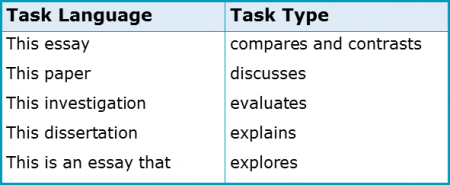
2. Topic and Arguments
While the purpose statement may be fairly formulaic, the majority of a thesis statement is composed of the essay topic (often created from the essay question) and the writer’s key arguments (also known as main ideas). With an inclusion of the previously mentioned purpose statement, the following table deconstructs our first thesis statement example (for an informative essay) into its key components.
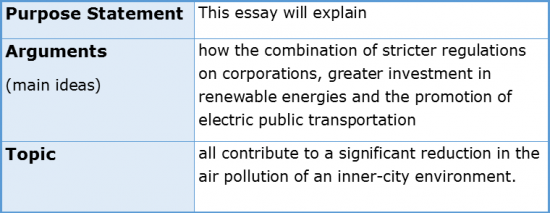
Sometimes, however, and particularly with persuasive essays, a student may be required to provide both arguments and counter arguments. Such a structure can be seen in the table below, which uses our second thesis-statement example:
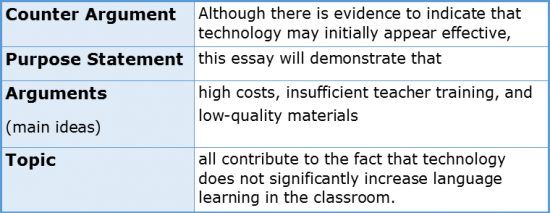
3. Stance
Another aspect that’s often required when writing persuasively such as in an evaluative essay is the inclusion of the writer’s stance. In short, stance is the author’s opinion about the overall argument of the essay. Does the writer, for example, agree or disagree with the essay question? When writing persuasively, such stance should usually be clear and apparent in an essay’s thesis statement and restatement, as well as in the body paragraph topic sentences. The figures below indicate the stance that exists in both of our example thesis statements:


4. Outlines
One final element of a thesis statement that should generally be included in an academic essay is what’s known as the outline (or roadmap). An outline is intended to inform the reader of (1) the essay’s key arguments (main ideas), and (2) the order in which those arguments will appear in the essay. We’ve provided our two example thesis statements for you below with each main idea underlined:
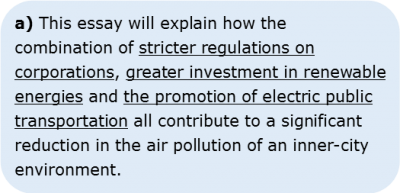
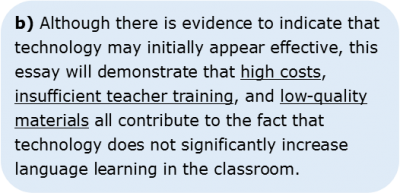
From these thesis statement outlines, the reader can presume the following essay structure if this were a five-paragraph essay. However, please note that there may in reality be some variation between the outline and the essay structure as the writer may decide to combine two main ideas into one body paragraph, perhaps including also a paragraph of counter argument.
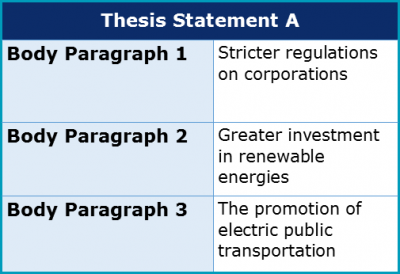
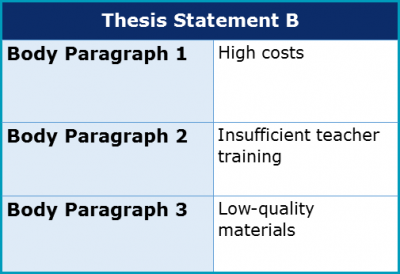
Having now discussed the four key elements of a thesis statement, the final chapter of this topic provides examples, tips and advice for how to write effective thesis statements every time.
To reference this reader:
Academic Marker (2022) Thesis Statements. Available at: https://academicmarker.com/essay-writing/introductory-paragraphs/thesis-statements/ (Accessed: Date Month Year).
Downloadables
Once you’ve completed all three chapters about thesis statements, you might also wish to download our beginner, intermediate and advanced worksheets to test your progress or print for your students. These professional PDF worksheets can be easily accessed for only a few Academic Marks.
Collect Academic Marks
-
100 Marks for joining
-
25 Marks for daily e-learning
-
100-200 for feedback/testimonials
-
100-500 for referring your colleages/friends